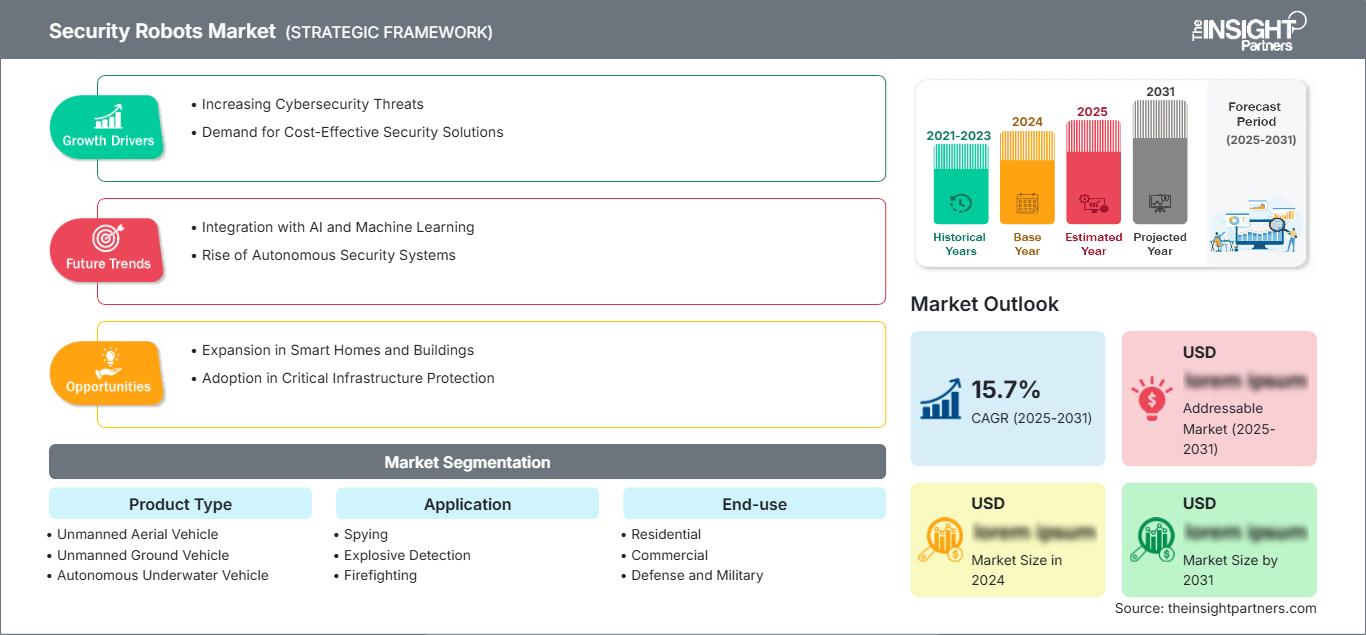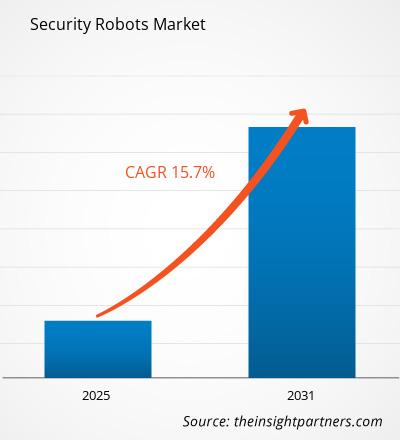Se espera que el mercado de robots de seguridad registre una CAGR del 15,7 % entre 2025 y 2031, con un tamaño de mercado que se expandirá de US$ XX millones en 2024 a US$ XX millones en 2031.
El informe está segmentado por tipo de producto (vehículo aéreo no tripulado, vehículo terrestre no tripulado, vehículo submarino autónomo), aplicación (espionaje, detección de explosivos, extinción de incendios, operaciones de rescate, otros) y uso final (residencial, comercial, defensa y militar). El análisis global se desglosa a nivel regional y por países principales. El informe ofrece el valor en USD para el análisis y los segmentos mencionados.
Propósito del Informe
El informe "Mercado de Robots de Seguridad" de The Insight Partners busca describir el panorama actual y el crecimiento futuro, los principales factores impulsores, los desafíos y las oportunidades. Esto proporcionará información a diversas partes interesadas del negocio, como:
- Proveedores/fabricantes de tecnología: Para comprender la dinámica cambiante del mercado y conocer las oportunidades potenciales de crecimiento, lo que les permitirá tomar decisiones estratégicas informadas.
- Inversores: Realizar un análisis exhaustivo de tendencias respecto a la tasa de crecimiento del mercado, las proyecciones financieras del mercado y las oportunidades que existen en toda la cadena de valor.
- Órganos reguladores: Regular las políticas y las actividades policiales en el mercado con el objetivo de minimizar el abuso, preservar la confianza de los inversores y defender la integridad y estabilidad del mercado.
Segmentación del mercado de robots de seguridad
Tipo de producto
- Vehículo aéreo no tripulado
- Vehículo terrestre no tripulado
- Vehículo submarino autónomo
Solicitud
- Espionaje
- Detección de explosivos
- Lucha contra incendios
- Operación de rescate
- Otros
Uso final
- Residencial
- Comercial
- Defensa y Militar
Geografía
- América del norte
- Europa
- Asia-Pacífico
- América del Sur y Central
- Oriente Medio y África
Recibirá personalización de cualquier informe, sin cargo, incluidas partes de este informe o análisis a nivel de país, paquete de datos de Excel, y además aprovechará grandes ofertas y descuentos para empresas emergentes y universidades.
Mercado de robots de seguridad: Perspectivas estratégicas

- Obtenga las principales tendencias clave del mercado de este informe.Esta muestra GRATUITA incluirá análisis de datos, desde tendencias del mercado hasta estimaciones y pronósticos.
Factores que impulsan el crecimiento del mercado de robots de seguridad
- Aumento de las amenazas de ciberseguridad: A medida que las ciberamenazas, como el hackeo, el malware y las filtraciones de datos, se vuelven más sofisticadas, crece la demanda de soluciones de seguridad automatizadas. Los bots de seguridad ofrecen monitorización 24/7, detección rápida de amenazas y respuesta, lo que ayuda a las organizaciones a mitigar riesgos y proteger datos confidenciales. La creciente frecuencia de ciberataques en todos los sectores está impulsando la adopción de bots de seguridad, que pueden identificar rápidamente vulnerabilidades y mejorar la ciberseguridad.
- Demanda de soluciones de seguridad rentables: Los bots de seguridad ofrecen una alternativa más asequible al personal de seguridad tradicional, ya que automatizan las tareas de monitorización y detección de amenazas. Ante la necesidad de reducir los costes operativos y mejorar la eficiencia, empresas de todos los sectores están adoptando cada vez más bots de seguridad para realizar tareas rutinarias de seguridad, lo que impulsa el crecimiento del mercado a medida que las organizaciones buscan soluciones escalables y rentables.
Tendencias futuras del mercado de robots de seguridad
- Integración con IA y aprendizaje automático: La integración de las tecnologías de inteligencia artificial (IA) y aprendizaje automático (AA) está mejorando las capacidades de los bots de seguridad. Estas tecnologías les permiten aprender continuamente de las nuevas amenazas, mejorando su precisión de detección y sus tiempos de respuesta. A medida que la IA y el AA evolucionan, los bots de seguridad se vuelven más inteligentes, eficientes y capaces de gestionar tareas de seguridad complejas en una amplia gama de sectores.
- Auge de los sistemas de seguridad autónomos: Existe una creciente tendencia hacia bots de seguridad totalmente autónomos capaces de realizar funciones de seguridad sin intervención humana. Estos bots pueden monitorizar entornos, analizar datos e incluso responder a incidentes, reduciendo la dependencia del personal humano. A medida que la tecnología avanza, se están implementando bots autónomos para tareas como vigilancia, control de acceso y neutralización de amenazas.
Oportunidades de mercado para robots de seguridad
- Expansión de hogares y edificios inteligentes: Con la creciente adopción de tecnologías para hogares y edificios inteligentes, los bots de seguridad ofrecen oportunidades para soluciones de seguridad integradas y automatizadas. Estos bots pueden supervisar propiedades, gestionar el acceso y alertar a los propietarios o administradores de edificios sobre posibles amenazas. A medida que crece la demanda de sistemas de seguridad conectados, surgen importantes oportunidades para los bots de seguridad tanto en el sector residencial como en el comercial.
- Adopción en la protección de infraestructuras críticas: Los bots de seguridad están ganando terreno en la protección de infraestructuras críticas como centrales eléctricas, centros de datos y edificios gubernamentales. Su capacidad para proporcionar vigilancia permanente, detectar intrusiones y responder a brechas de seguridad ofrece la oportunidad de salvaguardar activos vitales. A medida que aumentan las amenazas a las infraestructuras críticas, los bots de seguridad desempeñarán un papel cada vez más importante para garantizar la seguridad.
Perspectivas regionales del mercado de robots de seguridad
Los analistas de The Insight Partners han explicado detalladamente las tendencias regionales y los factores que influyen en el mercado de robots de seguridad durante el período de pronóstico. Esta sección también analiza los segmentos y la geografía del mercado de robots de seguridad en América del Norte, Europa, Asia Pacífico, Oriente Medio y África, y América del Sur y Central.
Alcance del informe de mercado de robots de seguridad
| Atributo del informe | Detalles |
|---|---|
| Tamaño del mercado en 2024 | US$ XX millones |
| Tamaño del mercado en 2031 | US$ XX millones |
| CAGR global (2025-2031) | 15,7% |
| Datos históricos | 2021-2023 |
| Período de pronóstico | 2025-2031 |
| Segmentos cubiertos | Por tipo de producto
|
| Regiones y países cubiertos | América del norte
|
| Líderes del mercado y perfiles de empresas clave |
|
Densidad de actores del mercado de robots de seguridad: comprensión de su impacto en la dinámica empresarial
El mercado de robots de seguridad está creciendo rápidamente, impulsado por la creciente demanda de los usuarios finales debido a factores como la evolución de las preferencias de los consumidores, los avances tecnológicos y un mayor conocimiento de los beneficios del producto. A medida que aumenta la demanda, las empresas amplían su oferta, innovan para satisfacer las necesidades de los consumidores y aprovechan las tendencias emergentes, lo que impulsa aún más el crecimiento del mercado.

- Obtenga una descripción general de los principales actores clave del mercado de robots de seguridad
Puntos clave de venta
- Cobertura integral: el informe cubre exhaustivamente el análisis de productos, servicios, tipos y usuarios finales del mercado de robots de seguridad, proporcionando un panorama holístico.
- Análisis de expertos: el informe se compila con base en el conocimiento profundo de expertos y analistas de la industria.
- Información actualizada: El informe asegura relevancia comercial debido a su cobertura de información reciente y tendencias de datos.
- Opciones de personalización: este informe se puede personalizar para satisfacer los requisitos específicos del cliente y adaptarse adecuadamente a las estrategias comerciales.
Por lo tanto, el informe de investigación sobre el mercado de robots de seguridad puede ayudar a descifrar y comprender el panorama de la industria y sus perspectivas de crecimiento. Si bien existen algunas preocupaciones válidas, las ventajas generales de este informe suelen superar las desventajas.
- Análisis histórico (2 años), año base, pronóstico (7 años) con CAGR
- Análisis PEST y FODA
- Tamaño del mercado, valor/volumen: global, regional y nacional
- Industria y panorama competitivo
- Conjunto de datos de Excel
Informes recientes
Informes relacionados
Testimonios
Razón para comprar
- Toma de decisiones informada
- Comprensión de la dinámica del mercado
- Análisis competitivo
- Información sobre clientes
- Pronósticos del mercado
- Mitigación de riesgos
- Planificación estratégica
- Justificación de la inversión
- Identificación de mercados emergentes
- Mejora de las estrategias de marketing
- Impulso de la eficiencia operativa
- Alineación con las tendencias regulatorias




















 Obtenga una muestra gratuita para - Mercado de robots de seguridad
Obtenga una muestra gratuita para - Mercado de robots de seguridad